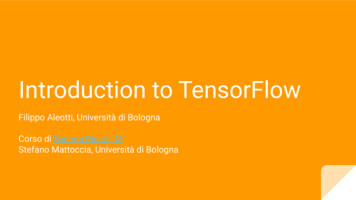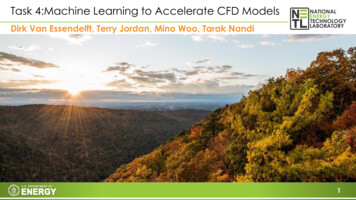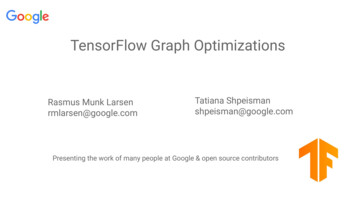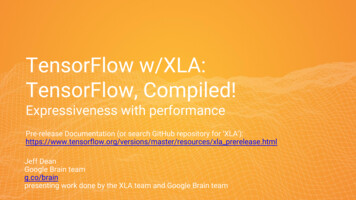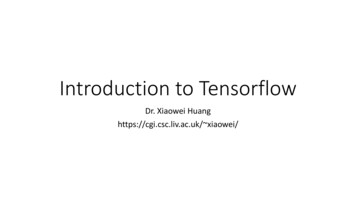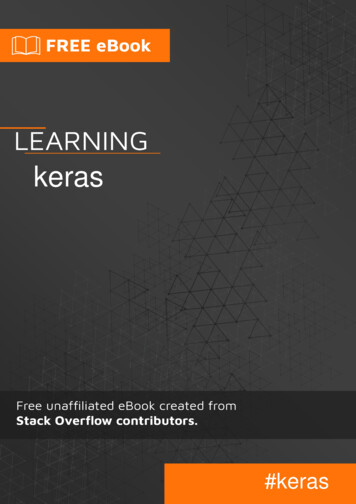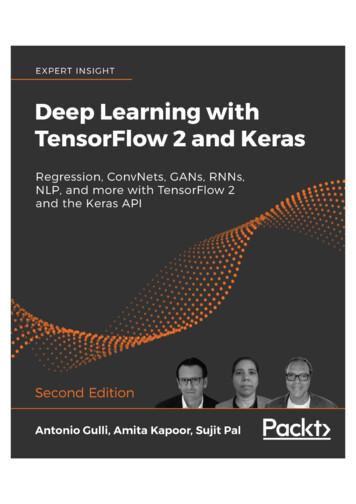
Transcription
TensorFlow on state-of-the-art HPC clusters:a machine learning use caseGuillem Ramirez-GargalloMarta Garcia-GasullaFilippo MantovaniComputer Science DepartmentBarcelona Supercomputing CenterBarcelona, Spainguillem.ramirez@bsc.esComputer Science DepartmentBarcelona Supercomputing CenterBarcelona, Spainmarta.garcia@bsc.esComputer Science DepartmentBarcelona Supercomputing CenterBarcelona, Spainfilippo.mantovani@bsc.esAbstract—The recent rapid growth of the data-flow programming paradigm enabled the development of specific architectures,e.g., for machine learning. The most known example is theTensor Processing Unit (TPU) by Google. Standard data-centers,however, still can not foresee large partitions dedicated tomachine learning specific architectures. Within data-centers, theHigh-Performance Computing (HPC) clusters are highly parallelmachines targeting a broad class of compute-intensive workflows,as such they can be used for tackling machine learning challenges.On top of this, HPC architectures are rapidly changing, includingaccelerators and instruction sets other than the classical x86CPUs. In this blurry scenario, identifying which are the besthardware/software configurations to efficiently support machinelearning workloads on HPC clusters is not trivial. In this paper,we considered the workflow of TensorFlow for image recognition.We highlight the strong dependency of the performance in thetraining phase on the availability of arithmetic libraries optimizedfor the underlying architecture. Following the example of Intelleveraging the MKL libraries for improving the TensorFlowperformance, we plugged the Arm Performance Libraries intoTensorFlow and tested on an HPC cluster based on MarvellThunderX2 CPUs. Also, we performed a scalability study onthree state-of-the-art HPC clusters based on different CPUarchitectures, x86 Intel Skylake, Arm-v8 Marvell ThunderX2,and PowerPC IBM Power9.Index Terms—TensorFlow, High Performance Computing, Parallel Computing, Machine Learning, Image Recognition, Training, Arm, Power9, x86, ClustersI. I NTRODUCTIONThe use of Machine Learning (ML) in research and industryis growing, and with its growth, there is an increasing need forcomputational resources able to efficiently handle ML workloads. One approach to cope with this request is to developdomain-specific architectures (the most prominent examplebeing the Tensor Processing Unit (TPU) by Google [1]).Another approach is to employ the latest generations ofGraphics Processing Units (GPU) offering ML specializedcores (see e.g., [2]). Another transversal approach is to linkthe back-end of ML frameworks to optimized libraries soto improve the performance (and the efficiency) of standardThis work is partially supported by the Spanish Government throughPrograma Severo Ochoa (SEV-2015-0493), by the Spanish Ministry ofScience and Technology project (TIN2015-65316-P), by the Generalitat deCatalunya (2017-SGR-1414), and by the European Community’s SeventhFramework Programme [FP7/2007-2013] and Horizon 2020 under the MontBlanc projects, grant agreements n. (288777, 610402 and 671697).homogeneous clusters based on high-end CPUs. This last approach can imply to leverage vendor-specific libraries targetingML (see e.g., [3]) or develop kernels optimized for specificoperations/kernels and architectures (see e.g., [4]).Since most data centers cannot afford to specialized theirhardware deployment for ML, it is essential to have MLtools making good use of computing resources, especiallyvery high-end resources like the one in High-PerformanceComputing (HPC) data centers. HPC data centers are traditionally populated with x86 architectures, but recently the trendis changing: the first ranked supercomputer of the Top500is indeed Summit, an IBM PowerPC architecture (boostedby NVIDIA GPUs). The Barcelona Supercomputing Center(BSC) hosts a 1.5 PFlops partition of compute nodes identicalto the ones installed in Summit. Also, for the first time inthe history of Top500, on November 2018 an Arm-basedsystem, Astra, also entered the Top500 [5]. The BSC isengaged through the Mont-Blanc project in enabling the Armarchitecture into HPC [6]. For these reasons, we present inthis paper how to leverage the Arm Performance Librarieswithin TensorFlow and a complete evaluation of TensorFlowon modern HPC clusters, including x86, Power9 and Arm.The main contributions of this paper are: i) the performanceevaluation of hybrid configurations of TensorFlow in threestate-of-the-art HPC based on different architectures; ii) themeasurement of the performance benefits when plugging theArm Performance Libraries to TensorFlow; iii) the study ofthe scalability of TensorFlow when running up to 1024 coresof state-of-the-art HPC clusters.The remaining part of the paper is organized as follows:in Section II we define our test case and the method used forperforming the following experiments. Section III summarizesthe HPC hardware platforms on which we performed ourtests; in Section IV we present the performance effects ofusing vendor-specific linear algebra libraries when runningTensorFlow, while in Section V we present the scalabilityresults measured on three HPC homogeneous clusters based ondifferent architecture, x86, PowerPC and Arm. In Section VIwe briefly compare our work with the most recent contributions related to TensorFlow in the HPC field. We summarizeour final comments in VII.
II. M ACHINE L EARNING E NVIRONMENTTensorFlow is an open-source library for Machine Learning(ML) applications e.g., for image classification, recommendation of applications, and speech recognition [7]. It is designedand implemented by the Google Brain Team, written in C and Python and some of its parts use CUDA for accelerationon GPUs. It consists of 650,000 lines of code. Both thescientific community and industry (e.g., Intel and NVIDIA)contribute to its development1 . It is employed as a benchmarkof new ML architectures [8] and as ML engine when coupledwith well-trained models [9].Concerning parallelism, TensorFlow defines intra-ops as thenumber of threads used by a kernel and inter-ops the level ofparallelism expressed at the node level of a graph, in otherwords, how many different kernels can be performed at thesame time. Horovod [10] is a distributed training frameworkfor TensorFlow and other machine learning frameworks. Weuse Horovod for allocating work among processes.Fig. 1. Time distribution among operations for the AlexNet model onMarvell ThunderX2 CPU.In Figure 1, we can see that 70% of the totalexecution time is spent in the Conv2DBackpropInputfunction, while 18% of the time is spent inConv2DBackpropFilter. Of course, speeding upthese two operations would improve the overall performance.We profiled (with perf) the inner calls and matched the mosttime-consuming functions and operations. As expected, all ofthem are part of the Eigen library. Eigen2 is a C libraryfor linear algebra. In the generic kernels (i.e., the genericimplementation of an operation), Eigen is used for tensoroperations. Since the Eigen library is a collection of linearalgebra functions, we studied how to replace some of the Eigencalls with the corresponding optimized implementations thatcan be found in vendor specific linear algebra libraries. Whilefor x86 architecture already existed a version of TensorFlowleveraging MKL, for Arm architectures we decided to test theArm Performance Libraries (ArmPL). Due to the dominance inthe execution time, we integrate calls to the Arm PerformanceLibraries first into the Conv2DBackpropInput andConv2DBackpropFilter operations.We perform our study using TensorFlow for training anetwork with images, using the benchmark tool from theTensorFlow repository3 . In order to avoid I/O overhead, weperform all tests with a synthetic image set, however for thescalability study we also tested the ImageNet data set [11]. Weapply two different models, ResNet-50 as an example of deepmulti-layer network and AlexNet for legacy reasons. Since weare applying machine learning techniques for image recognition, we try to express our results homogeneously, consideringalways images per second (img/s) as the performance figure.III. H IGH P ERFORMANCE C OMPUTING E NVIRONMENTFor our experiments we used three state-of-the-art production HPC clusters: MareNostrum4, Power9 and Dibona, eachone leveraging different architectures:MareNostrum4 is a supercomputer based on Intel XeonPlatinum processors, Lenovo SD530 Compute Racks, a LinuxOperating System and an Intel Omni-Path interconnection. Itsgeneral purpose partition has a peak performance of 11.15Petaflops, 384.75 TB of main memory spread over 3456 nodes.Each node houses 2 Intel Xeon Platinum 8160 with 24cores at 2.1 GHz, 216 nodes feature 12 32 GB DDR4-2667DIMMS (8 GB/core), while 3240 nodes are equipped with12 8 GB DDR4-2667 DIMMS (2 GB/core). MareNostrum4is the PRACE Tier-0 supercomputer hosted at the BarcelonaSupercomputing Center (BSC) in Spain and ranked 25 in theTop500 list of November 2018 [12].Power9 is also hosted at Barcelona Supercomputing Center.This cluster is based on IBM Power9 8335-GTG processorswith 20 cores each CPU operating at 3 GHz. Each computenode contains two CPUs, plus four GPUs NVIDIA V100 with16 GB HBM2. Each compute node is equipped with 512 GB ofmain memory distributed in 16 DIMMS of 32 GB operatingat 2666 MHz. Nodes are interconnected with an InfinibandMellanox EDR network and the operating system is Red HatEnterprise Linux Server 7.4. The Power9 cluster has beenincluded in our study because its computational elements arearchitecturally identical to the ones of the Summit supercomputer, ranked first in the Top500 of November 2018 [12]. Itmust be clarified that we do not consider in our evaluation theaccelerator part composed by the GP-GPUs.Dibona is an Arm-based HPC cluster, designed and deployed by ATOS/Bull within the Mont-Blanc 3 project. Its firstevaluation and benchmark is presented in [13]. Each computenode is powered by two Marvell’s ThunderX2 CPUs with 32cores each operating at 2.0 GHz. The main memory on eachnode is 256 GB of DDR4 running at 2667 MHz. Nodes areinterconnected with Infiniband Mellanox EDR network. TheDibona cluster has been considered for our study because itfeatures the same CPU technology that composes the Astrasupercomputer, the first Arm-based system ranked 204 in theTop500 list of November 2018 [5].In Table I we show the software environment used ineach cluster and for each version. We tried to keep the1 er/tensorflow2 http://eigen.tuxfamily.org/3 https://github.com/tensorflow/benchmarks
TABLE IE NVIRONMENT FOR EACH CLUSTERClusterTF 8.2.0MPIBack-End / Perf. Libs.OpenMPI 3.1.1OpenMPI 3.1.1OpenMPI 2.0.2.14OpenMPI 2.0.2.14OpenMPI 3.1.1MKL DNN v0.16ArmPL 19.0-Front-End Flags-mtune skylake-avx512 -march skylake-avx512 -O3-mtune skylake-avx512 -march skylake-avx512 -O3-march native -mtune thunderx2t99 -O3-march native -mtune thunderx2t99 -O3-mtune power9 -mcpu power9 -O3environment across clusters as homogeneous as possible basedon available software. We used the TensorFlow code in theversion 1.11, it has been modified only in the version usingthe Arm Performance Libraries (ArmPL), marked in the tableas TensorFlow version r1.11*. Also, we did not have accessto vendor specific libraries for Power9, so we evaluated onlythe vanilla version of TensorFlow on it.IV. I NTRANODE E VALUATIONIn this section, we evaluate the performance of TensorFlowwithin a computational node. We divide the study into twoparts; first, we study the effect on the performance (img/s)of changing the number of threads varying the batch size.Second, we evaluate the best configurations of MPI processesand threads when using all the computational resources of onenode.We perform both studies on the vanilla version of TensorFlow and the version leveraging vendor-specific linear algebralibraries (MKL for x86 and Arm Performance Libraries forArm). The goal is to be able to compare the improvement inperformance that can be achieved when using optimized linearalgebra libraries as back-end.For this evaluation, we use the three HPC clusters describedin Section III: MareNostrum4, Dibona, and Power9.We train our network for several epochs until it reaches asteady regime of img/s and checking the increasing trend of theaccuracy to ensure that the network is being effectively trained.We measure sustained performance as reported by TensorFlow.To provide a reasonable statistical accuracy, we average fourexecutions for each test. Since we notice variability below 10%in all our measurement campaign, we neglect error bars.Fig. 2. Thread Scaling of AlexNet with Vanilla version on one node ofMareNostrum4the scalability is reduced when reaching 24 threads, in thecase of MareNostrum4 this is the number of cores per socket.Therefore, it is not optimal to run a single process using thetwo sockets of one node. We can also observe that for batchsizes of 128, 256 and 512 there is almost no difference inperformance.A. Thread ScalingTo evaluate the performance of thread scaling within a node,we use the AlexNet model, and we increase the number ofthreads used by TensorFlow from one to the number of coresavailable for each architecture.In Figure 2 we can see the performance, expressed inimages per second when training the AlexNet model using thevanilla version of TensorFlow in MareNostrum4. The x-axisrepresents the number of threads and in the y-axis is shownthe performance obtained, the different series correspond tothe different batch sizes used for the training.We can observe that bigger batch sizes have a betterperformance than smaller ones. A batch size of 32 losesperformance when using more than 4 threads while a batchsize of 64 can scale up to 16 threads. For bigger batch sizesFig. 3. Thread Scaling of AlexNet with MKL version on one node ofMareNostrum4In Figure 3 is shown the performance of AlexNet inMareNostrum4 when running the TensorFlow version usingMKL libraries. Comparing Figure 2 and 3 we can observethat the performance is increased almost by 7 by usingthe optimized linear algebra libraries provided by the vendor(MKL libraries). In this case, we evaluated batch sizes up to8192, because for a high number of threads the performancecan still be improved by increasing the batch size.It is also interesting to see that when using de MKLlibraries the size of the batch size have a higher impact onthe performance. Also, the effect of using two sockets (48
threads) is worst when using the MKL libraries, resulting inworse performance than with 24 threads when using batchsizes of 512 or less.Fig. 6. Thread Scaling of AlexNet with Vanilla version on one node of Power9Fig. 4. Thread Scaling of AlexNet with Vanilla version on one node of Dibonaas for MareNostrum4, by the fact that a computational nodeis composed of two sockets, and it is not optimal to spawnthreads of the same process across different sockets.In Figure 4 we can see the performance of training theAlexNet model in Dibona with the vanilla version of TensorFlow. On the x-axis is represented the number of threadsused while on the y-axis the performance obtained in imagesprocessed per second.We can observe that the performance when increasing thenumber of threads drops at 16 threads, that is, before reachingthe number of threads corresponding to the cores in the socketin Dibona (32 cores per socket). In this case, we also observethat the performance increases with the batch size, being thedifference more important for a large number of threads.Fig. 7. Efficiency of AlexNet thread scalability in the different platformsFig. 5. Thread Scaling of AlexNet with ArmPL version on one node ofDibonaFigure 5 shows the performance obtained in Dibona usingthe modified version of TensorFlow leveraging the Arm Performance Libraries. We can observe that the performance is morethan 2 better than using the vanilla version of TensorFlow. Itis also important to notice that the Arm Performance Librariesversion delivers a good thread scaling up to 64 threads.Also in this case, we evaluated higher batch sizes as theperformance for a high number of threads increases for batchsizes above 512.In Figure 6 we plot the performance obtained in Power9when using the vanilla version of TensorFlow. In Power9we can observe a significant performance degradation whengoing from 20 to 40 threads. This effect can be explained,Figure 7 shows the efficiency e of the three clusters whenrunning with the batch size delivering the best performance.ptThe efficiency e is computed as e where pt is the(t · p1 )performance expressed in img/s when running with t threadsand p1 is the performance when running with one thread.We can observe that in MareNostrum4 the efficiency isalmost perfect up to 24 threads, but it drops for 48 threads.In the case of Power9, the efficiency is quite good up to 20threads, although it does not reach the efficiency obtained inMareNostrum4. The efficiency of Power9 drops at 40 cores,like in MareNostrum4, when using both sockets of the node.Finally, in Dibona, the efficiency decreases constantly whenincreasing the number of threads.B. Hybrid Configurations EvaluationWe have seen that TensorFlow in different machines andwith a batch size high enough can scale up to the number ofthreads of a socket (24 in MareNostrum4, 32 in Dibona and20 in Power9). In this subsection, we analyze which is theoptimum configuration between the number of MPI processesand the threads inside a computational node.For this evaluation, we use two different models: AlexNetand ResNet-50, and we will vary the distribution of resourcesamong processes and threads always using all the computational resources available.
In the previous subsection, we have seen that bigger batchsizes provide better performance. We have also observed thathigher batch sizes imply a higher memory consumption. Forthis reason, we cannot run the same batch size for all differentconfigurations, because in almost all the cases we run out ofmemory.In Table II we can see the different batch sizes used foreach configuration on each HPC platform.TABLE IIBATCH SIZE ASSIGNED TO EACH PROCESS , FOR EACH CONFIGURATION OFPROCESS THREADMareNostrum4AlexNetResNet-501 4881925122 2440962564 1220481288 610246416 35123224 23412148 117010DibonaAlexNetResNet-501 64512642 32256644 16256648 82566416 42566432 22566464 125664Power9AlexNetResNet-5040 15126420 22566410 4256648 52566420 22566440 125664Fig. 9. Performance of hybrid configuration of ResNet-50 model in MareNostrum4Fig. 10. Performance of hybrid configuration of AlexNet model in Dibonaconfiguration in both cases is using 4 MPI processes and 16threads per MPI process.Fig. 8. Performance of hybrid configuration of AlexNet model in MareNostrum4In Figure 8 we can see the performance obtained with different configurations when using AlexNet in MareNostrum4.On the x-axis are represented the different configurations asMPI processes threads.We can observe that when using the vanilla version the bestconfiguration is 8 6, and in general the configurations thatare not extreme (i.e., high number of threads or high numberof processes). But when using TensorFlow with MKL, the bestconfigurations are with the highest number of threads per nodeand only one or two MPI processes.Figure 9 contains the performance of ResNet-50 model inMareNostrum4. For this model, the best configurations of MPIprocesses and threads when using the vanilla version is verysimilar to the one obtained with AlexNet. The version thatuses MKL seems to be slightly different, being the worstconfigurations the ones in the middle. But, still, the best optionis to use a high number of threads and one MPI process.In Figure 10 we can see the performance in Dibona whentraining an AlexNet model with images. We can observea similar trend in the best configuration when using thevanilla version and the Arm PL one. In this case, the bestFig. 11. Performance of hybrid configuration of ResNet-50 model in DibonaFigure 11 shows the performance obtained by the differentconfigurations in Dibona when using the ResNet-50 model.For the ResNet-50 model, the best configuration is to spawn16 MPI processes and 4 threads each one. The trend is verysimilar to the one observed when using the AlexNet model.Figures 12 and 13 show the performance obtained in Power9using different configurations for AlexNet and ResNet-50models. In Power9 the best trend seems to be to use moreprocesses and fewer threads, being the best configuration forboth models to use 20 MPI processes and 2 threads each one.
Fig. 12. Performance of hybrid configuration of AlexNet model in Power9Fig. 14. Scalability of Alexnet model on the different platformsFig. 13. Performance of hybrid configuration of ResNet-50 model in Power9V. S CALABILITYFinally, we evaluate the scalability of AlexNet and ResNet50 in the three HPC clusters. For this evaluation, we use thebest configurations learned from the previous section. We usesynthetic images and real ones from the ImageNet dataset.In Table III we report a summary of the different parametersused to train the two models in the tree platforms.TABLE IIIC ONFIGURATIONS USED FOR EACH CLUSTER AND MODEL ResNet-50ConfigurationInter-opsBatch Size1 481 484 168 82 2020 2112220281925122048642048128In Figure 14 we can see the scalability up to 16 nodes of theAlexNet model. On the x-axis are represented the number ofnodes and on the y-axis the performance in images processedper second. It is interesting to see that the scalability is similarin all clusters, but also that in MareNostrum4 the differencein performance between using synthetic images or real ones ismuch higher than in the other clusters. This could be explainedbecause real images need to communicate through the networkmore than when using synthetic ones and the three clusters usedifferent network technologies.Fig. 15. Scalability of ResNet-50 model on the different platformsFigure 15 shows the scalability of the ResNet-50 model.We can see that the scalability of this model is worse andmore irregular than when using AlexNet in MareNostrum4and Power9. This can be explained by the fact that this modelis more complex due to its the deep multi-layer network.We see again that the performance with synthetic images hasa much better performance than the one achieved with realimages in MareNostrum4 compared to the other systems. Theperformance of the training phase of TensorFlow stronglydepends on collective communications. Also our three HPCclusters have different interconnection tecnology, Dibona andPower9 use Infiniband while MareNostrum4 uses Intel OnmiPath. Collective operations have different performance onthis two network technologies (see [13] for details), this couldexplain the results we obtain.For a deeper understanding of the behaviour at scale,Figures 14 and 15 can be complemented with the efficiencyheat map shown in Table IV. In the table we plot the relativePiefficiency Ei on each machine, computed as Ei ,(P1 · i)where Pi is the performance in images per seconds obtained
TABLE IVPARALLEL EFFICIENCY A LEX N ET AND R ES N ET-50 MODELS ON THEDIFFERENT PLATFORMSproject [6] as well es the evaluation of more recent Arm-basedarchitectures [19], [20].On the front of linear algebra library, we are in contact withthe developer of the Performance Library in Arm, and we planto continue our fruitful collaboration for improving the performance of TensorFlow on Arm platforms. As a contribution tothe data centers, following our previous experience describedin [21], we plan to evaluate TensorFlow in combination withcontainers technologies for an easier deployment for the users.VII. C ONCLUSIONSwhen running on i compute nodes and P1 is the performance inimages per seconds when running with a single node. Lookingat Table IV we see that the overall efficiency reaches 43%in the worst case, when running with 16 nodes using a realdataset on MareNostrum4. The most remarkable differencein the efficiency is visible on MareNostrum4 when runningwith 16 nodes with real image set: we can see that AlexNetachieves 94% efficiency, while with ResNet-50 the efficiencydrops to 43%. We can also notice that Dibona and Power9have better scalability, ranging between 70% and 99% whenusing 16 compute nodes with ResNet-50.VI. R ELATED AND F UTURE W ORKDue to the recent increase of interest for machine learningtechniques the literature provides several contributions that aresometimes overwhelming. In this section, we try to highlightthe papers that guided our study and, in our opinion, presenta similarity with our work.Shams et al. in [14] already performed a study of HPCclusters with machine learning framework. However, theyinclude accelerators (KNL and GPU), and they do not includeconsiderations about the effects of optimized linear algebraroutines.Our paper follows the idea of Cunha et al. in [15]. Improving the performance using optimized algebra library, in fact,is an implicit way for improving the strong scalability. Also,Sarbu et al. in [16] reinforce our approach since they focuson improving the performance of a sparse matrix kernel, yetanother way of improving the performance of the underlyingarithmetic libraries.We took as inspirational work the paper of Sakiyama etal. [17]: we both compare different architectures of HPCclusters, including a scalability study. We complement thework in [17] including Armv8 and IBM Power9 architecturesand extending the study to two models, AlexNet and ResNet50. Even if we do not focus on auto-tuning, the work ofHasabnis [18] helped us in the process of plugging the ArmPerformance Libraries into the back-end of TensorFlow.Finally, for the work on Dibona, our Arm-based platform, we acknowledge the previous work of the Mont-BlancOne of the main goals of this paper was to evaluateTensorFlow coupled with an algebra library optimized forArm. As proof of concept, we plugged the Arm PerformanceLibraries into some of the most compute-intensive kernelsof TensorFlow. We evaluated our optimized version with asynthetic workload and two models, AlexNet and ResNet50, on a state-of-the-art Arm-based cluster powered by ThunderX2, Marvell’s latest Arm CPU, and we measured a speedup between 1.5 and 2.3 .The second main contribution of this paper was to providean evaluation of TensorFlow on state-of-the-art HPC clusterswith the goal of understanding which are the most effectivehardware/software configurations that maximize the efficiencyacross different architectures.The first and most relevant observation is that the use ofvendor optimized libraries improves the strong scalability onboth clusters, x86, and Arm. With MKL on x86, we measurea performance improvement between 1.7 and 6.9 .Concerning parallelization strategies with processes andthreads, we noticed that with the Eigen back-end of TensorFlow the best configuration for all architectures and bothmodels is to balance in the mid-range the number of processesand the number of threads (configurations with all threads orall processes are the ones delivering less performance). Whenusing optimized libraries in the back-end, the configurationsusing more threads and fewer processes delivers overall betterperformance. This is more evident when using MKL onx86 probably because our modifications for leveraging ArmPerformance Libraries was not exhaustive for all the back-endcalls.If we look at the ML tool configuration, we can concludethat, when using optimized libraries with a high number ofthreads, users must increase the batch size to keep the bestperformance. So, further optimization is needed for use casesrequiring small batch sizes. Also, we are aware that reducingthe precision can imply a performance improvement. Howeverwe did not explore this corner in our current work: since noneof the CPU architectures offered specific reduced precisionfeatures, we left this for the future.Concerning a pure architectural comparison, conclusions areless sharp since our goal was not to find a winner ML CPUarchitecture. We can, however, observe that the difference inperformance between x86 and Arm could come from the sizeof the SIMD registers: in x86 the AVX512 extension offersregisters 4 bigger than the Arm NEON SIMD units. We
expect that the nature of tensor operations can take betteradvantage of larger SIMD units. Also, MareNostrum4 shows athread scalability close to ideal up to 24 threads, while Dibonaloses efficiency when increasing the number of threads. Asa general conclusion for all three HPC clusters, spawningthreads across sockets harms the performance. If we analyzethe scalability, the overall result is that scalability is betterwith AlexNet than with ResNet-50, but it is generally gooddisregarding the cluster architecture/configuration. A way forrefining the scalability study could be to focus on the performance of the collective operations within MPI or the I/Operformance when using real datasets. However, since we didnot want to fine-tune for a given HPC cluster, we preferred tofocus in this paper on the optimized back-ends leaving thoselow-level topics for a future study.R EFERENCES[14] S. Shams, R. Platania, K. Lee, and S.-J. Park, “Evaluation of deeplearning frameworks over different hpc architectures,” in 2017 IEEE 37thInternational Conference on Distributed Computing Systems (ICDCS).IEEE, 2017, pp. 1389–1396.[15] R. L. d. F. Cunha, E. R. Rodrigues, M. P. Viana, and D. A. B. Oliveira,“An argument in favor of strong scaling for deep neural networks withsmall datasets,” in Proceedings of High Performance Machine LearningWorkshop, Held in conjunction with IEEE SBAC-PAD 2018 (HPML18),2018.[16] P.-C. Sarbu and H.-J. Bungartz, “Optimization of a s
Concerning parallelism, TensorFlow defines intra-ops as the number of threads used by a kernel and inter-ops the level of parallelism expressed at the node level of a graph, in other words, how many different kernels can be performed at the same time. Horovod [10] is a distributed training framework for TensorFlow and other machine learning .

